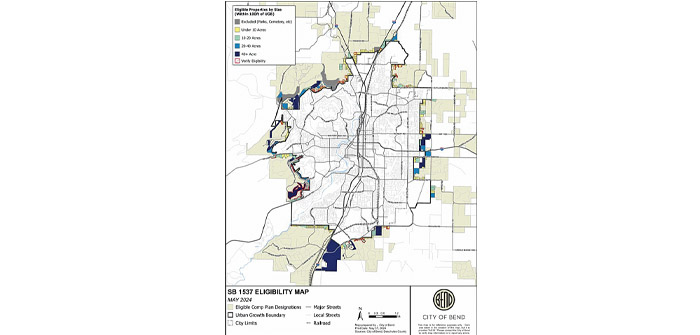(Graphic courtesy of City of Bend)
Senate Bill Offers One-Time Opportunity to Accelerate Housing Production
Bend is looking to take advantage of a potential window to fast-track expansion of the City’s Urban Growth Boundary (UGB) to accelerate the production of much-needed housing, including a sizable affordable proportion. The City of Bend is to publish widespread notices calling for site applications this month, following a June 20 council meeting decision to pursue the one-time opportunity, further to Oregon Senate Bill 1537 which offers incentives for speeding up growth.
The Bill came out of a request for the legislature to act urgently to allow cities an optional, one-time UGB amendment to provide additional land for housing to facilitate rapid housing production to meet Governor Tina Kotek’s housing production goals of 36,000 per year for the next ten years. Selected land of up to 100 net residential acres contiguous with the existing UGB boundary will be made “development-ready” (i.e., annexed/zoned, served with infrastructure, and not encumbered by protective regulations) with minimum affordability and development parameters outlined in the bill. “Net residential acre” means an acre of residentially designated buildable land, not including nondevelopable rights of way for streets, roads or utilities.
The Oregon Senate’s passage of the “Emergency Housing Stability and Production Package” was a top priority for Gov. Kotek, aiming to create more affordable housing by supporting housing production and making it easier for Oregon cities to create infrastructure. A major component of the bill is that within any expansion areas, 30 percent of all housing units must be legally restricted for affordable housing, an affordability requirement in Oregon that would be one of the strongest in the United States.
Resources will also be made available to encourage climate-friendly development for new affordable housing construction to incorporate energy-efficient design, reduce energy costs for low-income residents, and stabilize operational costs for owners. These incentives are designed to help reduce the energy burden for low-income Oregonians across the state.
For the City of Bend to qualify for this one-off accelerated expansion, it needs to prove housing need based on rent burden — households that spend more than 50 percent of their income on rent and utilities expenses are considered severely cost-burdened. Currently, Bend qualifies, but it may not in the future as the percentage of rent burdened has actually decreased because of people moving out of the city due to affordability concerns.
The City will obtain housing data from U.S. Department of Housing and Urban Development (HUD) later this summer, which will give staff a better idea about whether the City will continue to qualify. Because of this unknown, City staff members recommended expediting the process to try to seize the opportunity in a timely manner.
The expansion development must be in a single site, but multiple property owners could assemble to develop a single area, but the lots would need to be contiguous, or just separated by a right of way. Other location requirements are that the site must be on non-resource land — i.e., not zoned for farm or forest. In its simplest form, a UGB, is a regional boundary, set to control urban sprawl by mandating that the area inside the boundary be used for urban development and the area outside be preserved in its natural state or used for agriculture.
BreAnne Gale, a senior planner with the City’s Growth Management Division, said interest in this streamlined expansion opportunity is motivated by the need for affordable housing, to catch up on the City’s underproduction in recent history. Typically, UGB expansion can take several years to develop, plan, and realize. “Staff has spent a lot of time and effort over the last month drafting the selection application format, and we are looking to publish notices calling for site applications mid-August,” Gale said. “We want to cast the net pretty widely, including utilizing a list of existing interested parties. Applications should include a draft concept plan showing how they meet the requirements of the bill with elements such as adequate serviceability, and a breakdown of the number of units and their composition, including the affordability requirement.
“The more information an applicant provides the better, and the City Council will decide if the proposal meets or exceeds city requirements,” she continued. “We would also refer applicants to the June 20 meeting where councilors posed questions regarding areas such as compatibility and multi-modal connections consistent with council goals.
“We are aiming to have a Q&A session by early September, as well as offering pre-application meetings to go over compatibility. There will be a council work session on November 20, with a decision narrowing down to one site as soon as the following meeting December 4. There will also be a public input component, and we are planning an online open house to look at all applications, together with a public comment period and the opportunity to offer testimony at meetings. Once the decision is narrowed down to one site, the concept plan will be refined, and we would hope to adopt the UGB expansion as an amendment to the General Plan and annexed into the city limits by mid-2025.” The bill also requires that any site have a mix of both residential and commercial development.
The City embarked on its last UGB expansion in 2016 and even with the one-time addition coming from SB 1537, the City anticipates needing to expand further in coming years. Bend’s population is predicted to grow from 111,000 to 156,000 people by 2045, requiring more than 19,000 new housing units, according to a 2023 analysis. New planned developments are still under construction on land included in the 2016 expansion, which added 2,380 acres among ten areas on all sides of the city. The process took years and involved more than 70 public meetings.
New developments proposed through the UGB fast-track would still be subject to the city’s master planning process with the City Council having discretion in choosing a proposal. The UGB reduces sprawl by allowing for new types of development in specific areas with the city’s current boundary. In order for new development to occur, the city must determine how to adequately serve these new areas with infrastructure like roads, sewer, and water. Then, the expansion areas need to be annexed into the city limits before they are officially part of the City of Bend.
Senate Bill 1537 addresses Oregon’s housing supply and affordability crisis as decades of underbuilding have left the state with a severe housing shortage that is driving up rents, home prices, and worsening its homelessness plight.
The state is currently behind by 140,000 housing units and needs to produce over 440,000 units in the next 20 years to keep pace with demand. Furthermore, too many Oregonians can’t afford to live where they work, and employers are losing potential hires who cannot find an affordable place to live. Many Oregonians are being forced to leave their communities and some are leaving the state entirely. To address this critical economic and livability issue impacting all Oregon communities, the state must dramatically increase the production of housing units — up to 80 percent over current construction trends — to get Oregon on track to meet its future needs.
SB 1537 is a first step, and the key provisions of the bill were developed following months of stakeholder outreach to hear from local communities, climate organizations, homebuilders, and others on what tools are needed to address the ongoing housing crisis. While this tool does allow expedited and limited expansions for cities that have a need, it also has a series of requirements to ensure that expansion areas are the type of communities that Oregonians want: complete communities with diverse housing choices, a mix of densities, stores and restaurants, parks and open space, walking and biking infrastructure, affordable homeownership opportunities, and more.
Land cannot be high-value farm or forest land outside of urban reserves already designated for future urban development and is capped at no more than 75 or 150 acres, depending on city population. The tool is designed to ensure that as Oregon communities grow, they can accommodate urgently needed affordable and middle housing production, while also retaining the state’s natural beauty and diverse neighborhoods.
Funding for Housing Production Tools SB 1537 includes a $500 million investment package from existing state resources requested by Governor Tina Kotek to unlock more housing production by providing funding to build core infrastructure like water and sewer to support new housing development, and funding to moderate-income housing.






